Wakefulness, Wisdom, Community
Last night at the Hi-Pointe Sitting Group, someone asked if we could spend some of our time learning the Pali chants I use to start the sit. So we did!
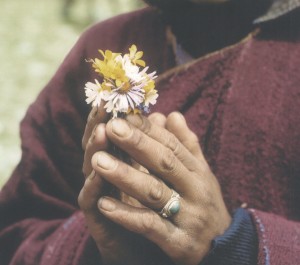 Here’s the Homage part of the chant in Pali (which we repeat 3 times):
Here’s the Homage part of the chant in Pali (which we repeat 3 times):
Namo tassa bhagavato arahato samma-sambuddhassa
Here it is in English:
Homage to the Blessed, Noble and Pefectly Enlightened One
Here’s the Refuges part in Pali (normally done 3 times, but we just do it once):
Buddham saranam gacchami
Dhammam saranam gacchami
Sangham saranam gacchami
Here it is in English:
To the Buddha I go for refuge
To the Dhamma I go for refuge
To the Sangha I go for refuge
For me, this means that I turn to Wakefulness (the Buddha), Wisdom (the Dhamma) and Community (the Sangha) for my place of safety and rest.
Of course chants are to be heard, not read. Click here for a terrific talk by Greg Scharf, where you can listen to these chants, and hear a beautiful reflection on what it means to pay Homage and Take Refuge.
(image from Offerings by Danielle and Olivier Follmi)
Fruits of Action
This month’s DPP homework has arrived and one of the topics is Karma. Cool. Turns out, one of the assigned readings is from Small Boat, Great Mountain, which I just finished (and posted about yesterday). So I’m ahead of the game already!
Another of the readings is from Seeking the Heart of Wisdom, by Joseph Goldstein and Jack Kornfield. Here’s a sampling:
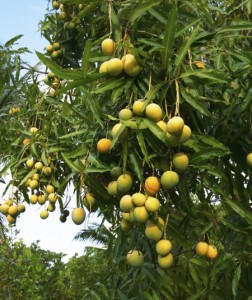 “The law of karma refers to the law of cause and effect: that every volitional action brings about a certain result. If we act motivated by greed, hatred, or delusion, we are planting the seed of suffering; when our acts are motivated by generosity, love, or wisdom, then we are creating the karmic conditions for abundance and happiness.
“The law of karma refers to the law of cause and effect: that every volitional action brings about a certain result. If we act motivated by greed, hatred, or delusion, we are planting the seed of suffering; when our acts are motivated by generosity, love, or wisdom, then we are creating the karmic conditions for abundance and happiness.
“And analogy from the physical world illustrates this: if we plant an apple seed, the tree that grows will bear apples, not mangoes. And once the apple seed is planted, no amount of manipulation or beseeching or complaining will induce the tree to yield a mango. The only meaningful action that will produce a mango is to plant a mango seed. Karma is just such a law of nature, the law of cause and effect on the psychophysical plane.
“…Another dimension of the law of karma helps in understanding how individual personalities develop. While it is true that there is no enduring entity, no unchanging self that can be called “I,” it is also quite obvious that each of us is a uniquely changing and recognizable pattern of elements.
“This comes about because each of us has in our own way, both consciously and unconsciously, cultivated different mind states. If we cultivate loving-kindness, we experience its taste in the moment and at the same time are strengthening it as a force in the mind, making it easier for it to arise again. When we are angry, we experience the suffering of that anger as present karma and are also strengthening that particular pattern of mind.
“…Who we are as personalities is a collection of all the tendencies of mind that have been developed, the particular energy configurations we have cultivated.”
But that’s not the end of the story:
“Our lives are a dynamic process of energy transformation, constantly flowing and changing, and we each have the power to determine the direction of our lives and to live in accord with our deepest values.
“If we become more conscious and awake, developing the ability to observe clearly, we can being to use our energy creatively and not be bound so blindly to past conditioning.”
Good thing!
Free!
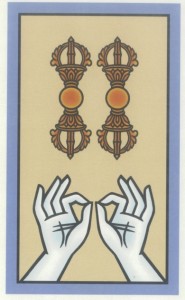 I’ve been reading a wonderful — and fascinating — book, called Small Boat, Great Mountain. It’s a compilation of talks by Ajahn Amaro given at a Dozgchen/Vipassana retreat in partnership with Tsoknyi Rinpoche at Spirit Rock several years ago. It’s wonderful for many reasons, not the least of which is the fact that it’s available FREE on iBooks or as a pdf here.
I’ve been reading a wonderful — and fascinating — book, called Small Boat, Great Mountain. It’s a compilation of talks by Ajahn Amaro given at a Dozgchen/Vipassana retreat in partnership with Tsoknyi Rinpoche at Spirit Rock several years ago. It’s wonderful for many reasons, not the least of which is the fact that it’s available FREE on iBooks or as a pdf here.
I am tempted to quote it at length. (It’s VERY readable. I’ve highlighted passages on just about every page.) But I’ll spare you that. Instead, I’ll give you a peek at the table of contents:
Essence of Mind
Ultimate and Conventional Reality
The Place of Nonabiding
Being Buddha
The View from the Forest
Cessation of Consciousness
Immanent and Transcendent
Who Are You?
No Buddha Elsewhere
Off the Wheel
The Portable Retreat
There’s also a very interesting Forward written by Drubwang Tsoknyi Rinpoche, an entertaining Preface by Guy Armstrong, and an excellent selection of Tibetan and Theravada chants.
Check it out!
(image from The Buddha Tarot by Robert M. Place)
The Dance Goes On
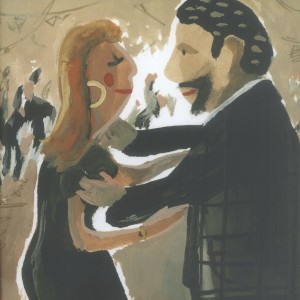 The Dancing with Life KM Group meets again tonight. We’re still finishing up the first section of the book by Phillip Moffitt, which focus on the First Noble Truth, the fact that there are difficulties, troubles, challenges…”suffering”…in this life.
The Dancing with Life KM Group meets again tonight. We’re still finishing up the first section of the book by Phillip Moffitt, which focus on the First Noble Truth, the fact that there are difficulties, troubles, challenges…”suffering”…in this life.
The passage I’m bringing for tonight’s discussion is from the very end of this first section, on page 72 in the hardback version. I chose it because it’s a reminder that acknowledging and accepting the fact of life’s “suffering” does not mean becoming a doormat, or a martyr, or in some way pretending that the problems and difficulties don’t matter.
It says: In practicing being with life just as it is, you still prefer that your suffering end and you act on that preference whenever possible.
But most crucially you do not demand that your difficulties go away. Instead, you consciously and voluntarily carry your suffering, and in your acceptance of it you find meaning….Astonishingly, when you fully accept dukkha [suffering], you also discover distance from your difficulties. The way out of suffering is the way through. As Sumedho says, “To let go of suffering we have to admit it into consciousness.”
(image from “A Whole World,” by Couprie and Louchard)
Good Choice
The Noah Levine passage wasn’t exactly right for Wednesday night’s sitting…although, who knows, maybe I should have given it a go. Instead, I closed the sit by reading Wild Geese, by Mary Oliver. (Always a good choice)
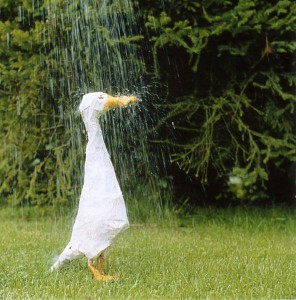 You do not have to be good.
You do not have to be good.
You do not have to walk on your knees
For a hundred miles through the desert, repenting.
You only have to let the soft animal of your body love what it loves.
Tell me about your despair, yours, and I will tell you mine.
Meanwhile the world goes on.
Meanwhile the sun and the clear pebbles of the rain
are moving across the landscapes,
over the prairies and the deep trees,
the mountains and the rivers.
Meanwhile the wild geese, high in the clean blue air,
are heading home again.
Whoever you are, no matter how lonely,
The world offers itself to your imagination,
calls to you like the wild geese, harsh and exciting–
over and over announcing your place
in the family of things.
(image from A Whole World, by Couprie and Louchard)
No Such Thing
And now for something entirely different…
 I was getting ready for last night’s Hi-Pointe Sitting Group, looking for something “pithy-yet-inspirational” to read aloud, and ran across this excerpt from Against the Stream, by Noah Levine (which was not at all right for last night’s sit, but which stayed with me, partly I think because Relationships and Sexuality are the topics for this month’s DPP homework, but mostly because I haven’t heard this subject talked about much in Dharma discussions, and certainly with not this much clarity.)
I was getting ready for last night’s Hi-Pointe Sitting Group, looking for something “pithy-yet-inspirational” to read aloud, and ran across this excerpt from Against the Stream, by Noah Levine (which was not at all right for last night’s sit, but which stayed with me, partly I think because Relationships and Sexuality are the topics for this month’s DPP homework, but mostly because I haven’t heard this subject talked about much in Dharma discussions, and certainly with not this much clarity.)
Here goes:
“While unconditional love can be nonattached, there is no such thing as unconditional relationship. When our love becomes sexual and thus relational, we impose certain conditions that are nonnegotiable.
“Fidelity, for example, and kindness and caring action–if these conditions aren’t present, the relationship will be a source of more pain than pleasure and will surely end in a broken heart, fractured spirit, and fatigued mind.
“Of course, the conditions of relationship don’t necessarily have to affect unconditional love, but most often when the container of loving sexual relationship is broken, the love itself is also somehow altered.”
Exactly.
Seeing Yet Again
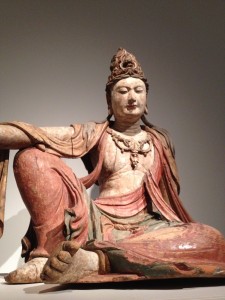 OK. I hadn’t planned to keep posting these “Now I See” exercises, but I feel like I’m on a roll, so here goes.
OK. I hadn’t planned to keep posting these “Now I See” exercises, but I feel like I’m on a roll, so here goes.
This is what I saw/wrote on yet another visit to Guanyin:
Now I see the tension in the pose. He/she looks more like a “he” at this moment and I see the poised action, the able-to-get-up-at-any-moment of the posture. He is relaxed…yes. Noble. Regal. Completely at ease in his power. And also alert. There is potential energy in the way he is resting his weight on one thigh. He sits firm. Solid. Still. And yet there is openness. The counterbalance of his outstretched arm, resting lightly on the bent and slightly backward-leaning knee implies a readiness to move. To get up. To respond. His head is tilted slightly forward. The momentum is there. He could arise at any moment.
And yet he rests. Serene. Untroubled. With eyes inward-focused. But listening, it seems.
Now I see that he is bare chested. And exposed. Draped with movement…or the potential for movement. His chest-piece rests, yet dangles. His garment falls away. His back is shaded and his shoulders are covered. But his chest is open. On display, almost.
“See,” he seems to be saying, “I am peaceful, but not enclosed. Not protected. I am stillness. But I am also movement. I am timeless, but embodied.”
Now I see that his flesh has weight, yet softness. It curves and folds. The delicate underside of one arm is open. The tender sole of one foot is up-turned and exposed.
“I am here to receive,” he says. “I can bear your viewing of me. Your projections. Your needs and desires. I am at rest, yet I am not unmoved. I will respond…but at a time when I choose. I am not insensitive to that which is directed toward me. I am present. Vulnerable. Open. I may become action at any moment. I am not passive. But I am not troubled. And I will not be disturbed.”
Another View
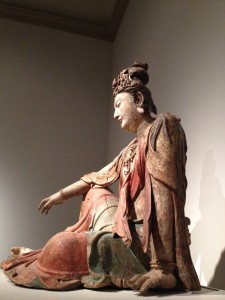 Yesterday I wrote about the “Now I See” practice I’ve been doing and I posted the last journal entry I wrote, after viewing Guanyin (for the sixth time.) Just to give you an idea of how the seeing can change, here’s the entries I wrote after the fourth viewing:
Yesterday I wrote about the “Now I See” practice I’ve been doing and I posted the last journal entry I wrote, after viewing Guanyin (for the sixth time.) Just to give you an idea of how the seeing can change, here’s the entries I wrote after the fourth viewing:
Now I see the cracks and splits in the wood. One vertical, right through the center of his/her breast. A shallower one, just below. There’s a large crack in the the drapery along the right arm. This one is deep and goes almost all the way through. Maybe entirely all the way though. And there’s another one, further down on her gown. A crack that breaks like a wound into her arm. I see the mottled effect of the whitewash fading, or of having been scrubbed away. And beneath, the tanned-flesh color of wood.
I see the graceful balance of the hand — the fingers of the hand — extended but relaxed. And the resting of the arm, at the elbow, on the knee. I see..even feel…the balance, the equilibrium of tension and weight, the pull of gravity, and heaviness of muscle on bone. I see the coming to rest of forces in the thigh and the arm, the pelvis open, the weight being born by the opposite arm. Born and supported by the ground below.
I see the suggestion of an opening in the eye, an eye that sees, from the corner of the lower lid. It is as if there is an awareness, but without focus. A soft seeing. Yet alert. I feel seen. But not watched.
I see the ring of folds on her neck. The plump softness of the wood-made-flesh. And now I see her earlobe…which is huge! A strand of greyed and green-gold hair falls/wraps across-and-around that surprising pendant, which is thicker and fuller than a thumb.
I see the complicated headdress she wears. Carved flowers and scrolls. Leaves. Buds. Stylized forms of nature suggesting growth and movement. In the center of the headdress–it’s a crown perhaps–there’s a flame, knotted, knob-like….the size to fit in the palm of the hand, and around the flame, a frame, flame-shaped, like a torch that is glowing, halo-ed.
And behind the crown — the hair, in a ball or sort of a pouch, sitting slightly forward, cantilevered, on the top of her head, with a rounded knob-point at the very top. So the effect, then, is what? A crown of flowers. And of fire. Hair that is growing, but contained. And yet there is a billowing up. There is a balancing here. Something constrained. Yet alive in some way.
Seeing Guanyin
In June, I posted about a contemplative practice, called “Now I See,” that involves looking at a piece of art again and again over a period of time, and writing after each viewing, always starting with the phrase, “Now I see….”
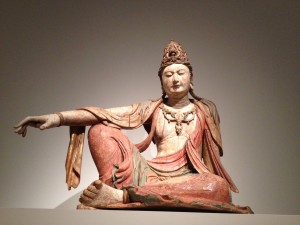 I chose an 11th century Guanyin statue, from northern China, that’s here in the St. Louis Art Museum. I started the practice on July 1. As of last Sunday, I’ve looked — and written — six times. (I plan to do it seven more.)
I chose an 11th century Guanyin statue, from northern China, that’s here in the St. Louis Art Museum. I started the practice on July 1. As of last Sunday, I’ve looked — and written — six times. (I plan to do it seven more.)
I wasn’t going to post what I wrote because I wanted to focus on the seeing and not on the writing.
But what the heck.
Here’s what I wrote this past Sunday:
Now I see her overall grace, peace and repose. Today she is definitely a “she,” though bare-chested and breast-less. The rosy pink of her robes, maybe, has something to do with it. But also the general rosiness of the glow that somehow makes itself known, though she is clearly made of wood and pigment, rubbed and worn. There is an unmistakable warmth. And honestly, a presence that is clearly not painted on.
She seems to be peace itself, though not in the lease bit passive. She sits still, yes. But there is an attentiveness. And active awareness. I’m not saying she’s alive. Or sentient. Or even “real,” whatever that would mean.
But I am saying that she has these qualities. That I see them. That they are present is this representation of her. In this work of art. Yes. All that. But more, too. It seems that I can “see” the intention of the artist. The craft and the genius, certainly. But also, I believe, the reverence. Reverence for the materials, of course. And for the act of creating, too. But mostly I can see the artist’s attention to the qualities of grace and peace, of active stillness, of ease, repose, nobility…and yet, too, of care and attention. There is nothing disconnected or detached about her stillness. She is gently, patiently attentive. And poised to act…when needed. But there is no reactivity in her. Receptivity, yes. Opennes. Even connection. But also dispassion. Which is not to say a lack of feeling. Rather, a lack of agitation.
And now I see her smile. Which is like a blessing. A smile of welcome. Of tenderness, of well-being. Her head is tilted slightly downward, but there is nothing condescending about it. No superiority. No distancing. Instead, I see an inclining toward. Not a reaching out–but an opening to. And now I see the inclination, the tilt, as a slight bow. Even she, the noble one, bows to that which comes before her. It is an act of acknowledgement. An act of honoring. Honor to what is. To the truth of it.
She bows. Nods. And even smiles. To whatever is present. She is not defended. She is not afraid.
This is peace itself. This is serenity. This is grace.
Another Cool Thing
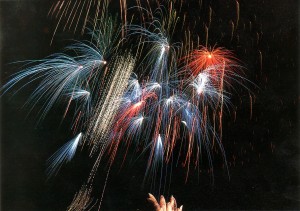 Oh….and at the end of the Hi-Pointe sitting on Wednesday night….there were fireworks!
Oh….and at the end of the Hi-Pointe sitting on Wednesday night….there were fireworks!
OK. It had nothing to do with the sit. There was a free concert going on at Art Hill, and when it was over, they shot off fireworks….
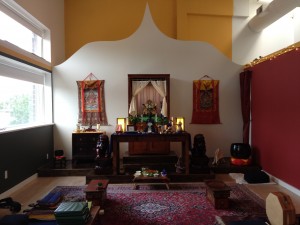 ….which we could see from the big, beautiful windows at the Blue Lotus Dharma Center…where we meet every Wednesday evening from 7:00 to 8:30 (shown here, in a photo taken during the day).
….which we could see from the big, beautiful windows at the Blue Lotus Dharma Center…where we meet every Wednesday evening from 7:00 to 8:30 (shown here, in a photo taken during the day).
The Center is located at 1002 Hi-Pointe Place, which is just behind and to the west of the Hi-Pointe Theatre, so mostly what you see out the front window is the giant AMACO sign on Skinker. That, along with the Buddhas and the Thangkas and the little white Christmas lights (along the top of the maroon wall) make for quite an eclectic setting.
I love it.
Come see for yourself!
(I didn’t take the photo of the fireworks above. It’s just one I had in my archive of images. But you get the picture.)
